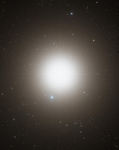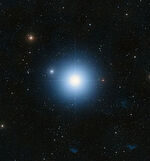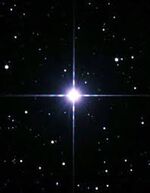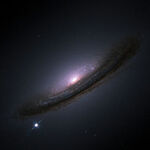This page contains a list of stars mentioned in Lost in Space, as well as of related concepts such as nebulae and galaxies.
Alpha Centauri[]
For the Alpha Centauri planet as seen on the Netflix series, see here.

Alpha Centauri is the closest star system to our own solar system. The mission of the Robinson Family in Lost in Space is to establish a colony on a planet orbiting one of the stars (Alpha Centauri A and Alpha Centauri B) that make up the star system. In the unaired pilot, Alpha Centauri itself is a planet in another galaxy, about 98 light years away. In the series, Alpha Centauri was a star as in real life, with at least 2 habitable planets. It was the only star within range of human technology that harbored a habitable planet. The episode "Return From Outer Space" incorrectly states that it is 5.3 light years away. In the episode "The Promised Planet ", the Robinsons believe that planet Gamma and planet Delta are in the Alpha Centauri system, however it turns out to be an alien trick and not Alpha Centauri at all. In the Innovation Comics, their destination planet is referred to as Proxima 4.
Altair[]

Altair is a star referred to several times in Lost in Space.
Altair Crucis[]
Altair Crucis is the star from which the Xenians claim to have come in “Kidnapped in Space.”
Andromeda Galaxy[]

The Andromeda Galaxy, also known as the "Great Galaxy of Andromeda" is a galaxy more than two million light-years distant from the Milky Way Galaxy. In "The Derelict", Judy wonders if a galaxy she sees could be Andromeda, mentioning that she had studied the galaxies back at school.
Verda was created by the Andromedan civilization, and on her planet in the Andromeda Galaxy there are no flowers (“The Android Machine”). Marvello claimed to have toured there as well ("Space Circus"). There is another planet in Andromeda where the children are 75 feet tall. ("The Toymaker")
Antares[]

Antares is the star around which the planet Antares 6 orbits, where Beelibones died around 1994. (Treasure of the Lost Planet )
In the New Series reality , a human mining colony exists in this system in the distant future, with exo-mining, gamma harvesting, and a gravity assist waypoint. The colony planet also had crystal forests and schools and spaceports., and a year there is 4000 days. But Antares A going supernova forces an evacuation, which had been known for several generations before it happened. The nebula created by Antares A is known as the BiFlexion Reach. (Lost in Space: Infinity's Edge)
Arcturus[]

Arcturus is a star mentioned in "Wild Adventure." After passing the sun, Don says that they should be able to see Earth passing by Uranus and Arcturus, an occurrence known as an occultation or transit, depending on the relative positions of the observer and the bodies involved.
Betelgeuse[]

Betelgeuse is a giant star referred to by Alonzo P. Tucker as “Bella-gee-zee."
Brightest Stars[]
The ten stars with the highest apparent magnitude when viewed from Earth are Sirius, Canopus, Arcturus, Alpha Centauri A, Vega, Rigel, Procyon, Achernar, Betelgeuse, and Hadar. Further information can be found here.
Comets[]

Comets are shown as incredibly hot, flaming bodies in Lost in Space. Even a near encounter is dangerous to a ship. In reality, comets are cold bodies that shine by reflected light.
Cosmic Bolts[]
Cosmic bolts is a phrase used in Lost in Space for a phenomenon resembling lightning.
Cosmic Dust[]
Cosmic dust is composed of small particles of matter in deep space. In “A Change of Space,” Will warns Dr. Smith that there may be bottomless cosmic dust pits on Priplanus. In “Blast Off into Space” Nerim’s blasting for cosmonium causes Priplanus to disintegrate into cosmic dust. Large balls of cosmic dust are present in deep space. They look like enormous balls of fire, but are actually harmless (“Wild Adventure”). Cosmic dust present in a planet's atmosphere can be harmful to the body if inhaled over a long period of time (“Forbidden World”).
Cygnus Nebula[]
The Cygnus Nebula is mentioned in “The Great Vegetable Rebellion.” It is near Tybo’s planet.
Dead Star[]
Arcon planned to send Dr. Smith to a dead star in “The Galaxy Gift.”
Fomalhaut[]

Fomalhaut is a star said to be near the Galaxy of the Southern Fish in “Blast Off into Space.”
Fontax[]
Fontax is the star near which Mr. Kidnoh is hiding ("Mutiny in Space”). It may be a deliberate or accidental change of the name of the constellation Fornax.
Fornack[]
Fornack is a star referred to in the Lost in Space episode “Mutiny in Space.” It may be a deliberate or accidental change of the name of the constellation Fornax.
Galaxy[]

Galaxy is often used in Lost in Space to mean a star system or star cluster, rarely being used correctly to mean an agglomeration of billions of stars held together by the force of gravity, millions of light years from other similar collections of stars.
Galaxy 14-Y[]
Galaxy 14-Y is a galaxy near which Space Lightship F-12 is stationed in “The Haunted Lighthouse.”
Galaxy 9H3[]
Galaxy 9H3 is a galaxy mentioned in “Deadliest of the Species.” Its inhabitants are similar to humans in appearance.
Galaxy of the Southern Fish[]
The Galaxy of the Southern Fish is home to Nerim. It was approximately a dozen light-years from Priplanus (“Blast Off into Space”).
Main Sequence[]
The main sequence is a continuous and distinctive band of stars that appear on plots of stellar color versus brightness. Such a color-magnitude plot is known as a Hertzsprung-Russell diagram after their co-developers, Ejnar Hertzsprung and Henry Norris Russell. Further information can be found here.
Milky Way Galaxy[]

The Milky Way Galaxy is the galaxy of which the Earth's sun is a member.
Nova Flare[]
In “Blast Off into Space” the Robinsons see a nova flare from their ship after take off. Maureen says it contains all the colours of the rainbow.
Omega Nebula[]
The Omega Nebula is a nebula that Will locates in “The Girl from the Green Dimension.” It is a few thousand light-years from Earth in the Sagittarius constellation.
Orion[]
Orion is the location in which the planet Orion 5 is situated. A planet near Orion has a CDS Ordering Machine on it, although it is unclear if it is on Orion 5 or not.
Polaris[]

Polaris is a star near the north celestial pole when viewed from Earth.
Procyon[]

Procyon is a star mentioned in “The Raft” as the first possible fix Don can expect to make before plotting the return course to Earth.
Siribidus Galaxy[]
The Siribidus Galaxy, near Earth, was perhaps the destination of Intergalactic Probe 22. Alpha Control sent out a string of fuel barges somewhere in that area for that probe in the year 1996.
Supernova[]

A supernova is a celestial phenomenon encountered in “Condemned of Space.” it appears as a giant purple flaming ball. It has a powerful magnetic pull, and if a spacecraft gets too close it, it could burn up.
Vegus[]
Vegus is a star mentioned in “The Promised Planet.” The star Vega may have been intended by the writers.
Xenian Galaxy[]
The Xenian Galaxy is the location of a civilization of androids ruled by one powerful computer leader. They have technology that allows them to control the passage of time. The Robinsons encounter Xenians aboard the Xenian Space Probe XL-73 in “Kidnapped in Space.”
Zeta Galaxy[]
The Zeta Galaxy is mentioned in “Deadliest of the Species.”
Zeta Star System[]
The Zeta Star System was the human designation for Solar System 14S3, a star system under the jurisdiction of the Zeta Galaxy Law Enforcement Bureau. The system contained at least three planets, with the third, 23.6 Gamma Range, being most habitable for humans (“Deadliest of the Species”).
